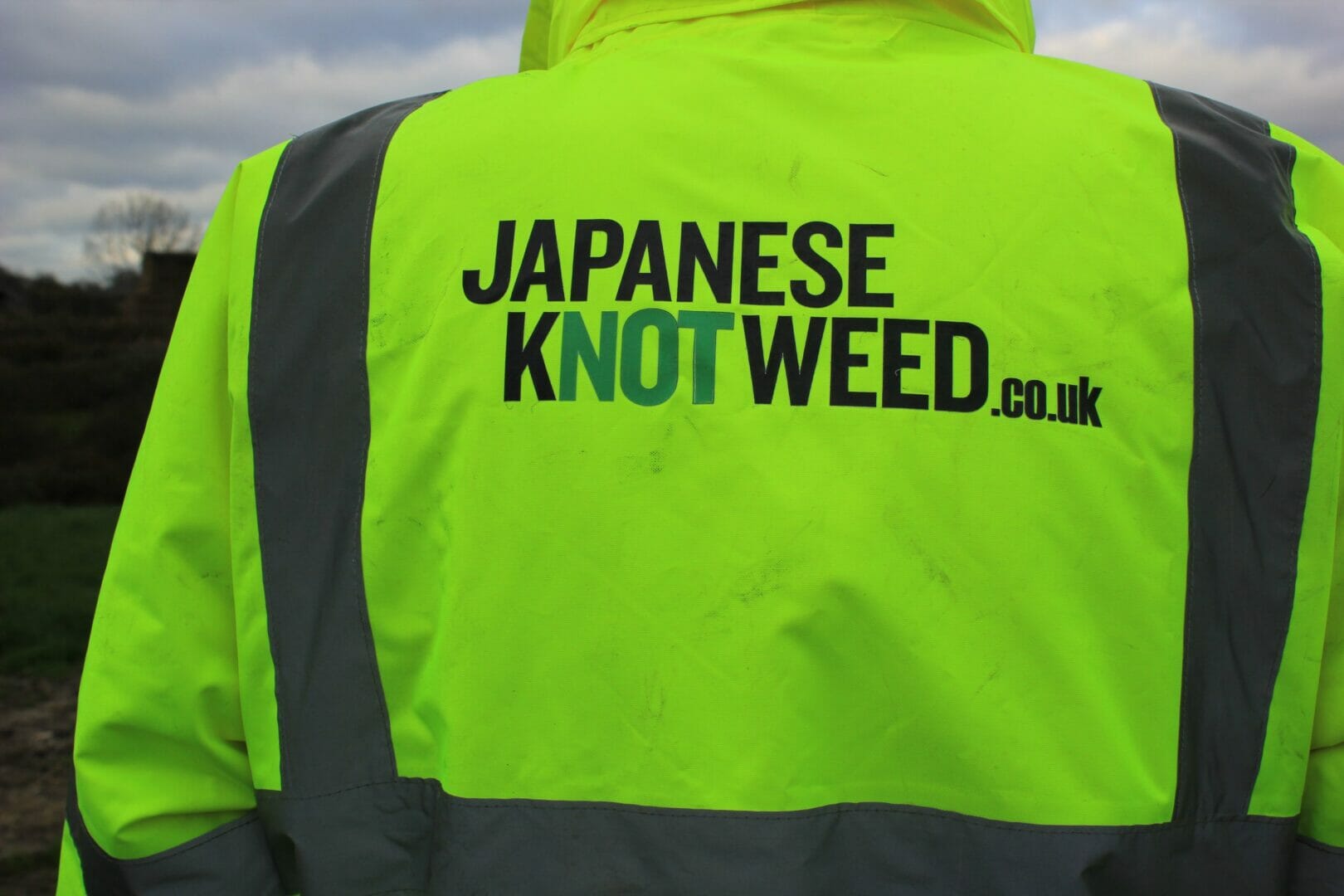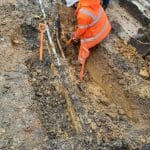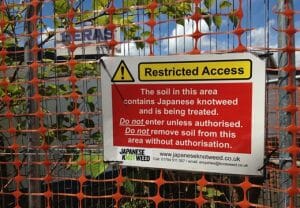
Earlier this year, we shared information on litigation cases surrounding Japanese knotweed.
In this editorial we provide advice on assessing and undertaking appropriate remedial work to either control or remove Japanese knotweed prior to developing a site and avoid potential litigation or environmental issues.
If knotweed is handled incorrectly, it could result in a long-term problem for the developer and landowner.
Where the presence of Japanese knotweed affecting the site is suspected, due diligence should be undertaken. Arrange an inspection/survey of the site by a PCA CSJK qualified surveyor. They will provide accurate identification of knotweed and a remedial works assessment.
Japanese Knotweed Removal Options
There are various options for Japanese knotweed removal, all of which can benefit from our Insurance Backed Guarantee
The Environment Agency states that once you find Japanese knotweed on a development site, it is essential that you produce a Knotweed Management Plan (KMP). The findings of the CSJK qualified surveyor including site plans, photos, and knotweed descriptions are detailed in the KMP along with an assessment of the appropriate remedial methods for the site.
The costs of removing Japanese knotweed can be kept to a minimum if it is identified and removed promptly.
Excavation is the best way to achieve complete knotweed removal and is the only way to ensure total removal. The appropriate excavation and waste disposal method will depend on access, site restrictions, development timescales and importantly the proposed development plan.
Knotweed Herbicide Control Options
Folia or Stem Injection Herbicide Treatment
Where there is no planned disturbance of the knotweed area and it is desirable for knotweed to be treated long term (over several years), then in-situ herbicide treatment can be considered.
Sustained treatment can damage the plant sufficiently to prevent it from producing above ground growth and guarantees can be provided to guard against any recurrence of above ground growth.
This is a cost-effective control method, but it does not remove the plant’s underground knotweed rhizomes from the soils of the site, which may remain in a viable but dormant state following successful treatment.
Disturbance of the ground containing the rhizome during or even after treatment can cause the knotweed to re-grow. The ground remains knotweed-contaminated requiring careful management and if any affected soils are removed from site, they will still be classed as controlled waste.
Herbicide treatment methods include stem injection, folia herbicide spraying and leaf wiping. Our herbicide programmes are packaged within a 10-year Herbicide Knotweed Management Plan complete with Insurance Backed Guarantee.
However, if there is a proposed change of land use for the knotweed area you should consider an excavation method.
 Knotweed Excavation and Waste Disposal Options
Knotweed Excavation and Waste Disposal Options
Mechanical Excavation & Removal of Knotweed Waste from Site to Landfill
The PCA Knotweed Code of Practice states that this should be considered as the method of last resort. Waste haulage and landfill disposal creates environmental impacts and can be expensive. However, complete excavation and offsite disposal does provide a hassle-free rectification of the knotweed problem. Leaving the site free to develop on completion and free of knotweed, which is often an attractive end position, especially to housing developers.
Mechanical Excavation & On-Site Waste Relocation for Herbicide Treatment
Where there is sufficient space on site sustainable waste disposal solutions can be considered, such as relocation. This includes excavating knotweed from an undesirable position and relocating it to location where is can be kept long term undisturbed and treated with herbicide. Where there is suitable space (e.g., public open space) this can be a cost-effective solution to eradicate knotweed from development works footprints.
Mechanical Excavation & On-Site Cell Burial
Another sustainable remedial process is where the excavated knotweed is buried deep on-site in a location where it will not be disturbed. The buried waste will need to be encapsulated in root barrier (to form the cell) with the top of the cell residing at least 2 metres below finished ground levels, covered with clean fill. The 2m depth is a precaution against future accidental human or animal (burrowing) disturbance.
Land Remediation Tax Relief for sustainable remediation methods
Land Remediation Tax Relief (LRTR) can be claimed for disposing of excavated knotweed on-site such as the relocation, cell-burial, or herbicide methods. LRTR can provide up to 150% capital gains tax relief.
Example of Works Undertaken
Recently, we worked for a large UK housebuilder to remediate Japanese knotweed and other invasive weeds in southern England. We worked alongside Ecologists, Demolition contractors and Archaeologists during the COVID-19 pandemic.
Summary
- Acted as Principal contractor (working to CDM regulations).
- Worked with Ecologist to protect hibernating reptiles.
- Co-ordinated with Archaeological works.
- Enabled demolition works and dealing with unmarked underground services.
- Worked within tree root protection zones.
- Implemented our management plan for the excavating and treatment of invasive weeds.

Working with Other Contractors
The onsite knotweed measured over 125m2, and we were unable to freely move our plant and equipment across site due to presence of hibernating reptiles.
There was discovery of unmarked underground services within knotweed contaminated areas. These areas had to be hand dug to fully expose the services and allow inspection for removal of the knotweed in this area.
There were tree protection zones within the site where we mechanically scraped and excavated under Watching Brief of an Arboricultural Consultant. We carefully scraped layers of ground, an inch at a time. If we had encountered tree roots, we would have resorted to hand digging. This area of works was completed with root barrier capping.
 Japanese Knotweed Removal
Japanese Knotweed Removal
Japanese knotweed locations were carefully and fully excavated to remove knotweed rhizomes.
Care was taken to ensure we only removed knotweed contaminated ground, thus reducing the overall waste volumes and project costs.
The knotweed contaminated waste once removed from site was classed as controlled waste and removed via registered waste carriers to a specifically licensed landfill facility for disposal. In total, we removed over 720 tonnes of knotweed waste from site.
Other Onsite Invasive Plants
In addition to Japanese knotweed, there was also Rhododendron ponticum and Himalayan balsam onsite, both of which are listed as invasive species within the Wildlife & Countryside Act 1981, Section 14, Schedule 9, part 2.
We cut down the Rhododendron, opening up the densely vegetated area. The cut stumps of the Rhododendron were treated by drilling and installing Ecoplugs (capsules) to provide slow-release herbicide delivery into the plants.
The balsam was growing within a Site of Special Scientific Interest (SSSI) area and the use of herbicide for control was not permitted. Therefore, we hand-pulled the balsam before the plant could flower and produce seeds, thus controlling and preventing its spread. Both the Rhododendron and balsam works are long-term, where we will conduct repeat monitoring and treatments for several years to gain control of the invasive plants.
Working for You, Whatever the Weather
During the works, there was torrential rain, making excavating and moving equipment and contaminated soil around the site much more challenging.
Knotweed: Do’s and Don’ts
 Where possible, all areas affected by Japanese knotweed should be fenced off and isolated from any activities on site immediately, to avoid potential knotweed spread. The fencing should be erected at least 7 metres away from any visible knotweed growth to protect rhizome disturbance.
Where possible, all areas affected by Japanese knotweed should be fenced off and isolated from any activities on site immediately, to avoid potential knotweed spread. The fencing should be erected at least 7 metres away from any visible knotweed growth to protect rhizome disturbance.
No material is to leave site from the knotweed areas, except as part of specially supervised knotweed treatment works. No new materials should be stored in or adjacent to Japanese knotweed areas.
Where there is a high risk of knotweed infestation from neighbouring land, contact the landowner and agree on a co-ordinated treatment programme.
Any presence of knotweed off-site can present the likely potential for re-infestation of the site across site boundaries.
Contact the Japanese Knotweed Experts
Japanese Knotweed Ltd is a Safety-First, PCA, national knotweed company, with industry-leading expertise and an annual turnover of £4.6m.
In 2020 we delivered approximately 150 excavation projects and we currently have over 6,000 herbicide customers, completing approximately 8,000 herbicide programme treatment visits annually.
T: 01794 339866
